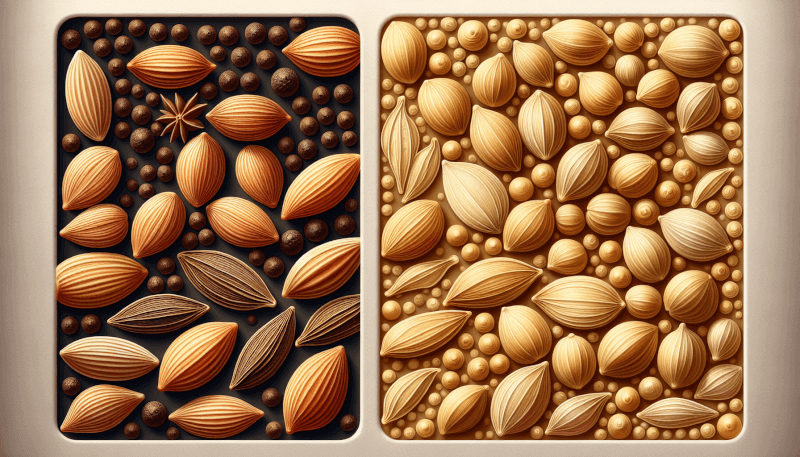If you’ve ever come across recipes that call for cumin seeds and coriander seeds, you may have wondered if they are interchangeable. While they may look alike, cumin seeds and coriander seeds are distinct in their flavor profiles, origins, and culinary uses. In this article, we’ll explore the similarities and differences between these two aromatic seeds and help you understand how to properly use them in your cooking adventures. So, the next time you find yourself questioning whether cumin seeds and coriander seeds are the same, you’ll have all the answers at your fingertips.
Cumin Seeds
Physical Characteristics
Cumin seeds, also known as jeera, are small oval-shaped seeds that measure about 4-5 mm in length. They have a warm brown color and are slightly lighter than coriander seeds. Cumin seeds have a ridged texture that adds a unique visual appeal to dishes.
Flavor and Aroma
Cumin seeds have a distinctive aroma and a warm, earthy flavor with a hint of bitterness. When toasted or ground, their flavor intensifies, releasing a strong nutty and peppery taste. The aroma of cumin seeds is potent and has a slightly sharp, yet pleasant fragrance that adds depth to any dish.
Culinary Uses
Cumin seeds are widely used in various cuisines around the world. They are a staple ingredient in Indian, Mexican, Middle Eastern, and North African cooking. In Indian cuisine, cumin seeds are commonly used as a tempering agent in curries, lentils, and rice dishes. They are often dry roasted before being added to dishes to enhance their flavor. Cumin seeds are also ground into a powder and used as a spice rub for meats and vegetables.
Health Benefits
In addition to its culinary uses, cumin seeds offer several health benefits. They are rich in antioxidants and have anti-inflammatory properties, which may help reduce the risk of certain chronic diseases. Cumin seeds are also a good source of iron, which aids in the production of red blood cells and helps prevent anemia. Furthermore, cumin seeds have been traditionally used to aid digestion and alleviate symptoms of digestive disorders.
Cultivation and Availability
Cumin seeds are predominantly grown in regions with a dry climate, such as India, Iran, Turkey, and Egypt. They are harvested from the plant known as Cuminum cyminum, which is a member of the parsley family. The seeds are typically dried and used whole or ground. Cumin seeds are widely available in grocery stores and spice markets, both in whole and powdered form.
Coriander Seeds
Physical Characteristics
Coriander seeds, also called dhania, are small round seeds that measure about 3-5 mm in diameter. They have a light golden-yellow color and a smooth, polished surface. Coriander seeds are slightly larger and rounder than cumin seeds, giving them a distinct appearance.
Flavor and Aroma
Coriander seeds have a unique flavor profile, combining citrusy, earthy, and slightly floral notes. They have a mild, sweet taste with a subtle hint of lemony freshness. When crushed or ground, coriander seeds emit a warm, aromatic fragrance, which adds a delightful aroma to dishes.
Culinary Uses
Coriander seeds are widely used in various cuisines, particularly in Indian, Middle Eastern, Thai, and Mexican cooking. They are commonly used as a spice in curries, soups, and marinades. Coriander seeds are often roasted before grinding to enhance their flavor. They can also be used as a condiment in pickles, chutneys, and spice blends.
Health Benefits
Coriander seeds offer a range of health benefits. They are rich in antioxidants and have anti-inflammatory properties that may help reduce inflammation and oxidative stress in the body. Coriander seeds have been traditionally used to aid digestion and alleviate symptoms of indigestion. They are also believed to have antimicrobial properties that may help fight against certain types of bacteria.
Cultivation and Availability
Coriander seeds are harvested from the Coriandrum sativum plant, which belongs to the parsley family. They are grown in various parts of the world, including India, Morocco, Russia, and Central America. The seeds are typically dried and used whole or ground. Coriander seeds can be found in most grocery stores and spice markets, both in whole and powdered form.
Differences Between Cumin Seeds and Coriander Seeds
Appearance
One of the primary differences between cumin seeds and coriander seeds lies in their appearance. Cumin seeds are small, elongated, and have a warm brown color, while coriander seeds are slightly larger, rounder, and have a light golden-yellow color. These differences in appearance can help distinguish the two spices when used in culinary preparations.
Taste and Aroma
Cumin seeds have a distinctive warm, earthy flavor with a hint of bitterness when compared to coriander seeds. On the other hand, coriander seeds have a mild, sweet taste with citrusy and floral undertones. The aroma of cumin seeds is strong and peppery, while coriander seeds emit a pleasant warm, aromatic fragrance.
Culinary Uses
Both cumin seeds and coriander seeds are widely used in various cuisines, but they have different culinary applications. Cumin seeds are commonly used as a tempering agent in Indian cuisine and are also popular in Mexican, Middle Eastern, and North African dishes. Coriander seeds, on the other hand, are used as a spice in Indian, Middle Eastern, Thai, and Mexican cooking. They are often roasted before grinding to enhance their flavor.
Nutritional Composition
While cumin seeds and coriander seeds offer similar health benefits, their nutritional compositions differ slightly. Cumin seeds are a good source of iron, providing about 20% of the recommended daily intake per tablespoon. They also contain small amounts of vitamin C, calcium, and magnesium. Coriander seeds, on the other hand, are rich in dietary fiber, providing about 41% of the recommended daily intake per tablespoon. They also contain moderate amounts of iron, calcium, and vitamin A.
Similarities Between Cumin Seeds and Coriander Seeds
Flavor Notes
One notable similarity between cumin seeds and coriander seeds is their flavor notes. Both spices have warm, earthy undertones that add depth and complexity to dishes. While cumin seeds have a slightly bitter taste, coriander seeds bring a mild sweetness to the flavor profile. The combination of these flavor notes in various culinary preparations creates a harmonious balance and enhances the overall taste.
Health Benefits
Cumin seeds and coriander seeds share several health benefits. Both spices are rich in antioxidants and have anti-inflammatory properties that promote overall well-being. They are believed to help reduce the risk of chronic diseases and aid digestion. Additionally, both spices offer nutritional value, with cumin seeds being a good source of iron, and coriander seeds being a rich source of dietary fiber.
Culinary Combinations
Cumin seeds and coriander seeds are often used together in culinary preparations to enhance the flavor of dishes. The combination of these spices adds complexity and depth to curries, stews, and spice blends. They complement each other’s flavors and create a harmonious taste experience. The unique blend of cumin seeds and coriander seeds is a common feature in Indian cooking, where the two spices are often used as a base for many dishes.
Recipes with Cumin Seeds and Coriander Seeds
Cumin-Coriander Powder
Ingredients:
- 1 cup cumin seeds
- 1 cup coriander seeds
Instructions:
- Heat a pan over medium heat and add the cumin seeds and coriander seeds.
- Dry roast the seeds for about 3-4 minutes or until they release a fragrant aroma, stirring continuously to prevent burning.
- Remove the seeds from the heat and let them cool completely.
- Grind the roasted seeds in a spice grinder until you have a fine powder.
- Store the cumin-coriander powder in an airtight container for future use.
Cumin-Coriander Roasted Vegetables
Ingredients:
- 2 cups mixed vegetables (such as carrots, potatoes, bell peppers, and cauliflower)
- 2 tablespoons olive oil
- 1 teaspoon cumin-coriander powder
- Salt and pepper to taste
Instructions:
- Preheat the oven to 400°F (200°C).
- In a mixing bowl, combine the mixed vegetables, olive oil, cumin-coriander powder, salt, and pepper. Toss well to coat the vegetables evenly.
- Spread the coated vegetables on a baking sheet in a single layer.
- Roast the vegetables in the preheated oven for about 25-30 minutes or until they are tender and golden brown, stirring once halfway through.
- Remove the roasted vegetables from the oven and serve hot as a side dish or as a delicious addition to salads or wraps.
Cumin-Coriander Rice Pilaf
Ingredients:
- 1 cup basmati rice
- 1 tablespoon ghee or butter
- 1 teaspoon cumin-coriander powder
- 2 cups water
- Salt to taste
Instructions:
- Rinse the basmati rice in cold water until the water runs clear. Drain the rice and set aside.
- Heat ghee or butter in a saucepan over medium heat.
- Add the cumin-coriander powder to the hot ghee or butter and sauté for about 1 minute to release the flavors.
- Add the rinsed basmati rice to the saucepan and stir well to coat the rice grains with the spice mixture.
- Add water and salt to the saucepan and bring it to a boil.
- Reduce the heat to low, cover the saucepan with a tight-fitting lid, and let the rice simmer for about 15-20 minutes or until all the water is absorbed and the rice is cooked.
- Once the rice is cooked, fluff it gently with a fork and let it rest for a few minutes before serving.
Conclusion
In conclusion, cumin seeds and coriander seeds may share some similarities, such as their warm flavor notes and health benefits, but they also have distinct characteristics that set them apart. While cumin seeds have an earthy and slightly bitter taste, coriander seeds offer a mild sweetness with citrusy undertones. Both spices are widely used in various cuisines to enhance the flavor profiles of dishes. Whether you use them separately or combine them in recipes, cumin seeds and coriander seeds add depth and complexity to your culinary creations. So the next time you’re preparing a meal, reach for these versatile spices and elevate your dishes to a whole new level of deliciousness.




